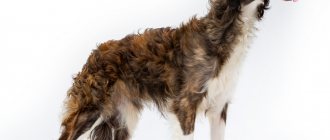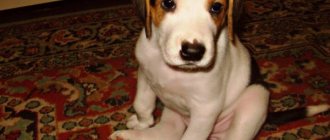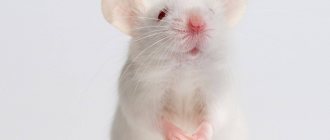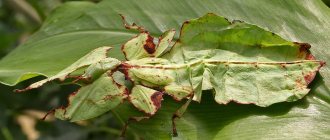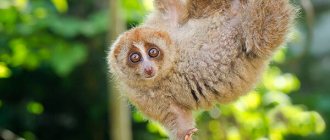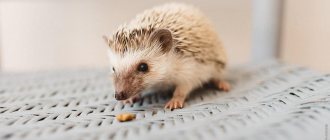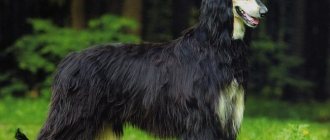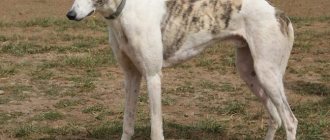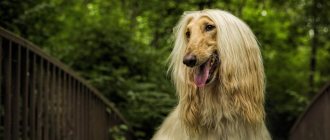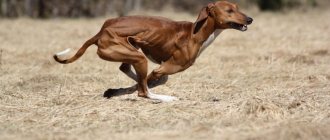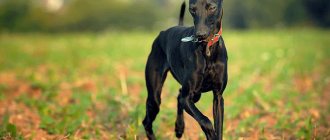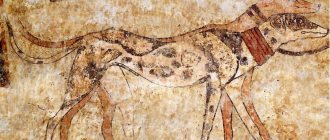This is a dog of late development. Males usually reach full development by three years of age. Bitches earlier. The proper development of a greyhound depends on the conditions of keeping and nutrition. There is an opinion that a greyhound raised in a village looks less purebred, simple, and often physically underdeveloped. Many rural hunters believe that such greyhounds work better in the field. They work well due to their heredity.
And if they were well-grown, they would work better, longer. But there are many rural hunters who have healthy, beautiful dogs that are not inferior to those in the cities.
It is absolutely not necessary to keep a greyhound in the house. It is enough to provide her with an insulated place in the barn with plenty of straw bedding in winter and, of course, good feeding. From the barn, it is advisable to have a hole covered with burlap into a fairly spacious enclosure.
It is very important for the proper development of the puppy and the growing individual high-quality food, as well as exercise in the air.
. Walking is required.
History of the Russian Borzoi breed
Mentions of dogs, with which our ancestors successfully hunted not only hares, but also wolves, can be found in printed publications of the 17th century. Presumably the first and most famous breeder of greyhounds was the Russian Tsar Alexei Mikhailovich Romanov, who received several dogs of this breed as a gift from the Zaporozhye Cossacks. The version that the ancestors of today's Russian greyhounds were brought to us from Persia and the Kazakh Khanate during the time of Ivan the Terrible also has a right to life. The autocrat had great respect for hunting greyhounds and was quite sincerely interested in new hunting breeds.
Russian greyhound
Since the 18th century, the clan of greyhounds has been subjected to large-scale “pumping”. To improve the hunting qualities of dogs, they began to cross them with Hort and English, and subsequently with Crimean and mountain greyhounds. Selection activity took place spontaneously, since the main breeder of the breed remained the noble class, which kept its own kennels and had the opportunity to experiment with breeding to its heart’s content. Not limited by any boundaries, landowners bred animals, guided only by their own preferences, which ultimately led to the fragmentation of the greyhound family and slowed down the standardization of the breed. As a result, the first dog conformation standard was written only in 1888.
The breed began appearing at domestic exhibitions in 1872 and almost immediately disappointed all aesthetes who saw the animals as ordinary mestizos who had lost the classic features of the Russian greyhound. But the panel of judges at the Moscow Exhibition of the Imperial Society for Proper Hunting treated four-legged competitors more kindly and in 1874 awarded a gold medal to a Russian greyhound named Reward. But even this decision did not put an end to the desperate debate among experts about exactly what a proper Russian greyhound should look like. As a result, traditionalists continued to advocate for a return to the original type of appearance of the dogs, while the other half of the breeders stubbornly voted for the updated appearance of the greyhounds.
Since the beginning of the 20th century, the breeding of Russian greyhounds was carried out at an accelerated pace, and by 1917 the number of purebred individuals in Russia exceeded 2000. Of course, during the years of the Civil War and the Great Patriotic War, the clan of Russian greyhounds suffered significant losses, but nevertheless did not cease to exist , which made it possible for Soviet enthusiasts to once again start breeding these amazing animals. The breed came to America and Canada at the beginning of the 20th century, after Europe had had plenty of fun with the grace and hunting talents of its representatives and even managed to cool down a little towards them. By the way, it was on the other side of the Atlantic that Russian greyhounds gained the greatest popularity, where they were accepted not as hunters, but as sports, image pets.
Interesting facts about the breed
- 1. Many paintings by Russian artists depict a Russian greyhound (Sokolov P.P. “Gathering for hunting at the porch”, Stepanov A. “Wolf hunting with greyhounds”, etc.)
- The dog can reach speeds of almost 100 km/h;
- Has excellent instincts. Can track prey at a distance of 800 m from itself;
- “Russian Wolfhound” is what foreigners call the dog. After all, a fragile-looking creature can cope with a wolf.
- The emblem of the Russian Cynological Association is the greyhound;
- Representatives of the breed almost do not smell like dogs.
Appearance of the Russian Borzoi
Russian Greyhound Puppy
Russian Greyhounds are the epitome of sophistication and elegance. Among their peers, these lean, ascetic beauties stand out for their refined appearance and mesmerizing ease of movement. Despite their fairly high height (males - up to 85 cm at the withers, females - up to 78 cm), Russian greyhounds do not give the impression of heavyweight giants. At one time, this feature of the breed was very subtly played up by the genius of the Art Nouveau era, Louis Icarus. As soon as the artist depicted the elongated, proud silhouette of the Russian greyhound in his paintings a couple of times, it became a fashion trend, and illustrations, engravings and even sculptures glorifying the regal bearing of greyhounds fell on French and Russian fans of the breed as if from a cornucopia.
Head
The skull of the model Russian Borzoi has an elongated shape, which is why the dog's head appears very narrow. The occipital protuberance of representatives of this breed is quite pronounced, and the stop line is noticeably smoothed.
Teeth and bite
Hi, neighbor!
The teeth of the Russian Borzoi are strong and white. The bite can be straight or scissor.
Nose
The bridge of the nose is long, with a slightly noticeable hump. The lobe is large, mobile, protruding forward.
Eyes
The Russian Borzoi has beautiful expressive eyes: almond-shaped, slightly convex, rich brown color.
Ears
The ears of the Russian Borzoi are miniature, thin, set slightly above eye level. The ear flap is noticeably drawn towards the back of the head, and its tips are pressed tightly against the neck. In an excited or alert dog, the ears become erect.
Neck
The neck of the Russian Borzoi is dry, quite long and muscular. On the sides, the muscles are slightly flattened, which is why the neck looks flattened.
Muzzle of a Russian greyhound
Frame
Thanks to the muscular back and massive, sloping croup, the topline forms a long arc, which is more pronounced in males. The chest of Russian greyhounds is deep, oval in shape, less than or equal in width to the croup. The abdominal area is well toned: the bottom line is steep, with a so-called tuck.
Legs
Running Russian greyhound
The front legs of the Russian Greyhound are dry and well muscled. The shoulder blades are long, sloping, the elbows are normal, looking back. The hind limbs of the RPB are set wider than the front ones. The thighs are elongated, moderately muscled, the hock joints are wide, well developed, with normal angles. The paws of representatives of this breed are narrow, arched, and hare-like. The Russian greyhound moves in everyday life at a light trot, and when hunting - with sweeping jumps (fast trot).
Tail
Crescent-shaped, long and thin, with a lush dewlap. The calm Russian Greyhound has a tail that hangs down. If the dog is excited, the tail can rise, but not higher than the level of the back.
Wool
Russian greyhounds at an exhibition
The dog's body is covered with long, wavy or slightly curly hair. On the ears, head and front of the legs the hair is very short and silky. On the animal’s neck there is a lush pendant made of dog clothes, and the back of the thighs is decorated with cute “pants.” In the area of the croup and shoulder blades the curl of the coat is steeper.
Color
All types of spotted and piebald colors are assigned to Russian greyhounds, with the exception of blue and chocolate tones. The dewlaps on the dog's neck and tail, as well as the fur on its thighs, are usually lighter than the rest of the body. A distinctive feature of dark-colored individuals is a muzzle with a so-called mazurina (black mask).
Defects and disqualifying defects
Depending on the severity, defects in appearance can be either minor or serious. And if, for example, a Russian greyhound never receives the highest score for its coarse coat or lightweight constitution, then for aggression and an asymmetrical bite it risks not being allowed to participate in competitions at all. Most often, the exhibition commission rejects Russian greyhounds for fundamental differences with the breed standard, for example, for the blue color of the iris, the absence of one of the teeth, a blue or brown shade of the coat, as well as for the presence of dewclaws. Incorrect position of the fangs, which damages the soft tissues of the oral cavity, also leads to complete disqualification.
Breed standard
The head is in the form of a narrow wedge, the muzzle is narrow and very long. Due to the large amount of curly hair on the body, the head appears very small in relation to the body. However, if you remove it, then it is quite proportional and harmonious.
The eyes are quite large for a small and narrow head, the gaze is penetrating and intelligent.
The nose is large, voluminous, black, regardless of color.
The ears are in the form of small triangles, hanging, tightly pressed to the skull. In general, they do not stand out particularly well and are more invisible than visible.
The body is long, flat, the back is curved, the chest is deep.
The belly is retracted, the tail is lowered down, slightly tucked at the end.
The paws are dry, sinewy, and high. In profile it seems that the dog is very impressive, in front it looks flat.
The wool is beautiful, silky, wrapped in soft rings, very soft to the touch. Acceptable colors :
- black and piebald;
- red-piebald;
- grey-piebald;
- tricolor;
- sexual;
- murugiy;
- grey;
- white.
Photo of a Russian greyhound
Character of the Russian Borzoi
Russian greyhounds are real geniuses of transformation. When hunting, they are unstoppable and passionate, but as soon as the animals find themselves within the walls of their home, the melancholy quiet ones immediately awaken within them. In general, Russian greyhounds are one of the most convenient pets: they are “little talkative” and do not follow their owner’s tail to get their share of attention. The Russian greyhound prefers to spend its time free from hunting and walking in a passive manner, resting on the sofa or nestling at the feet of the owner. The breed is also not capable of all sorts of unpleasant surprises, such as torn wallpaper and holey shoes, provided, of course, that the dog is walked regularly.
Russian greyhound with his owner
The Russian Greyhound doesn’t feel much love for children, but it doesn’t harbor much hostility either. What irritates her most is sudden screams and laughter, so when noisy children's groups come to the owner's home, the dog, as a rule, tries to retreat. Due to their peaceful nature and innate delicacy, Russian greyhounds are moderately polite in communication, including with strangers, but in return they demand exactly the same attitude towards themselves. Possessing a very vulnerable psyche, the Russian greyhound is extremely sensitive to any injustice, so punishment for this breed is a real tragedy.
Increased excitability is another distinctive character trait of Russian greyhounds. Just now your pet was strolling imposingly at your feet, but then a random catfly loomed on the horizon, and your phlegmatic dog seemed to be blown away by the wind. The reason for such a sharp transition from one state to another is the pursuit instinct, which in this breed has evolved to the level of mania.
The intellectual indicators of the Russian greyhound are quite good, although inexperienced owners may initially encounter difficulties in raising and training their pets. It is important to understand here that the Russian Greyhound is not a companion or a service dog, but a professional hunter whose main goal is to work with game. Accordingly, all the intelligence and ingenuity of the breed goes into the process of baiting the animal. At the same time, in ordinary life, a dog’s brain works in energy saving mode, which is sometimes mistakenly regarded as stupidity.
Russian greyhounds with a child
Fight
Content Features
Some see the Russian greyhound as a restless and restless animal, the maintenance of which in an apartment or house is fraught with great difficulties, but here the opposite is true. In the house the dog behaves calmly and even lazily. For days on end she will lie on the sofa or on the floor, and her presence will be almost unnoticeable. She does everything serenely and unperturbed, even stealing from the table with her characteristic aristocracy. Also suitable for year-round keeping in a yard or enclosure.
In the cold season, the greyhound will not take long walks. When walking in cold weather, she must constantly move. For additional insulation, some owners wear blankets, sweaters and other clothing tailored to the weather. Most models feature a high collar.
Exercise stress
Contrary to popular belief, a greyhound does not require long daily walks. There is no need to travel tens of kilometers with it. Dogs need explosive loads, a sharp burst of energy that they can control themselves, for example, a couple of laps around the field. It is the opportunity to burn off energy that is the main problem of keeping dogs in the city. A greyhound will be enough if the owner can take the dog to the field at least a couple of times a week.
Walking on a leash is not enough for a greyhound, even if it lasts 4 hours.
Preparing the dog for the season deserves special attention. She must be in good physical shape. It is much easier for greyhounds who live outside the city to prepare for a hunt. Participation in coursing or racing in the off-season helps keep your dog in good shape.
Care
There is nothing complicated about caring for a Russian greyhound. It is enough to brush the dog once a week with a thick massage brush and wash it as needed. After walking in tall grass, it is advisable to comb the coat and remove plant debris. It is not recommended to use the fuminator even during seasonal molting.
The owner must also monitor the condition of the eyes, ears and teeth. Ears are checked once a week and cleaned as needed. To prevent tartar, children are given special toys, beef tendons, or are taught to brush their teeth. The long claws of a greyhound should reach the ground, but if they are not ground down in time, the position of the paws changes and you have to trim them yourself.
Nutrition
Its formation and condition depend on proper nutrition of the greyhound. It is important for a growing dog to get enough animal protein. It is the building material for muscles and ligaments. If a greyhound does not receive enough protein during puppyhood, it has poorly developed muscles or abnormal limb structure. Other components of the diet are no less important. The approximate ratio of proteins, fats and carbohydrates in the diet should be 2:1:2. Deviation is desirable only in the direction of increasing protein.
Most greyhound owners prefer to feed their dogs natural products with the obligatory introduction of vitamin and mineral supplements.
The amount of food for a growing puppy is determined simply: as much as he can eat. A properly raised dog is not prone to overeating as an adult. Meat and offal are given raw or cooked. Boiled ones are better digested, raw ones are more useful. Minced meat is mixed with porridge and grated vegetables.
The Russian Greyhound is predisposed to gastric volvulus, so owners should be very careful about preventing an acute condition.
If desired, you can accustom your greyhound to ready-made dry food. Higher premium food is suitable for large dog breeds. During periods of active physical activity and before the hunting season, portions are increased or switched to a high-calorie diet.
Education and training
Despite the fact that the majority of Russian greyhounds are supple and obedient dogs, they do not make the most diligent students. By the way, experienced hunters are of the opinion that enrolling representatives of the breed in the OKD (General Training Course) will only spoil their natural talents. With a Russian greyhound you always need to keep your finger on the pulse: one random cry or a sharp threatening movement towards the dog - and she immediately regards this as an attempt to humiliate its dignity. So you should behave respectfully during lessons with these “aristocrats”. Moreover, the Russian greyhound is one of those breeds whose representatives have a pronounced individuality, so the program and style of training for each individual individual can vary dramatically.
Russian greyhound training
The first and most important skill that an owner must develop in his pet is the ability to clearly distinguish between hunting and ordinary life. Gently wean your puppy from chasing everything that moves during walks - the command “Near!” to help. Never let him off the leash if there are smaller four-legged creatures nearby. Trying to raise a Russian greyhound to become a domestic servant and a circus performer is also not worth it. Despite their gentle nature, greyhounds will not bring slippers and walk on their hind legs.
You will have to forget about monotonous training with this breed, since monotony for the Russian greyhound is the worst of evils. Guide your dog seriously, but not forcefully, rewarding success with treats. By 6 months, the puppy should have learned basic obedience commands (“Come to me!”, “Near!”) and be able to walk on a leash. The time period from 6 to 10 months is considered the period of teenage rebellion. A mature dog tries to assert his own authority, ignoring prohibitions in every possible way. During this period of time, it is better to be patient and restrain yourself as much as possible when the desire arises to give the shaggy lawless man a good beating in the loins.
It is better to combat teenage leadership in Russian greyhounds with additional physical activity. Moreover, the more work and training you put on a presumptuous puppy, the less time he will have for petty dirty tricks. The easiest way in this regard is for owners who, in addition to the puppy, already have an adult Russian greyhound at home. An experienced dog will quickly put a teenager who is stunned from an overabundance of energy in his place, becoming an example and senior mentor for him.
Russian greyhounds with a girl in a red dress
Origin story
The Russian greyhound is a very ancient breed, so precise information about its origin and formation has not been preserved. Presumably, the first greyhounds were brought to Rus' by the Tatar-Mongols, who copied hunting with them from the Persians and Arabs.
Judging by written data, by the 16th century a certain type of Russian greyhound had already been formed, but the wide distribution of the breed was hampered by the high cost of puppies. For centuries, peasant hunting dogs were known as huskies, hounds were available to landowners, but greyhounds were only available to very wealthy people.
The breed got its name from the words: “dog” - soft, long hair, and “greyhound” - frisky, fast.
In different provinces, greyhounds differed in character, external features and were called by the owner's surname. By the end of the 19th century, the type became more or less homogeneous. Since 1874, greyhound exhibitions began to be held in Moscow. The first standard was adopted in 1888. From this moment the formation of the Russian greyhound as a breed began. At the beginning of the 20th century, in the Moscow Hunter Society named after. Alexander I opened a stud book. In 1902, the first volume was published, in which only 15 dogs were recorded. In the 80s in Russia there were about 3,000 greyhounds, of which about 2,000 had a pedigree. The breed was accepted by the International Canine Association in 1956. Throughout almost all of history, other greyhound breeds have been used in canine breeding, so the old type is very different from the modern one. Below in the gallery you can see a photo of a Russian greyhound from 1902.
Purpose
The Russian greyhound is used for baiting free-ranging sighted animals in open areas. The dog’s task is to quickly catch up with the rising animal, maintaining a short distance, not to lose sight of it and not allow it to hide in a ravine or in the bushes. The greyhound takes the animal in its place, strangles it and remains nearby until the hunter arrives. For a long time, horseback hunting with greyhounds was popular. Often, hounds were used together with hunters, who found and picked up game.
It is believed that the speed of reaction of the Russian greyhound has no equal. She has the amazing ability to quickly see a raised or running animal.
At the last moment of approaching with prey, a good greyhound makes a short lightning-fast jump. It should be noted that these dogs have excellent agility, strength and endurance, quick reaction, passion and fearlessness, which is called anger. In addition, they are distinguished by good catchability; rare living creatures will be able to escape from them.
Features of hunting with a Russian greyhound
They hunt with the greyhound on rough terrain, mainly in the middle zone. A dog needs 300-400 m of open space to catch a fox, wolf or hare. They begin hunting in the fall, when the temperature drops below 15 degrees. In hotter conditions the dog will have a harder time working.
The Russian canine is called the “shot dog” for a reason. She has lightning-fast excitability when she sees an animal. An internal impulse forces her to rush into pursuit with maximum agility and maintain speed at a distance of up to 500 meters. Usually this is more than enough to reach the beast and take it. The greyhound is considered the fastest dog among greyhounds, but the Russian greyhound is not much inferior to it in speed. 3-4 full-fledged races on the animal per day with breaks of 30-40 minutes is a very good indicator for a greyhound.
Unfortunately, most hunters do not train their dogs outside of the season, so dogs that are untrained, or even those who do not even know what they were bred for, are used for hunting. Good training and education, even with simple natural characteristics, allows you to get better results than from a high-breed dog with poor training.
Video about dogs of the Russian Greyhound breed:
Hunting with a Russian greyhound
Hunting with a Russian Borzoi
The Russian greyhound is an excellent hunter in the middle zone, with which you can hunt hares and foxes, as well as a wolf, with equal success. And the point here is not only in natural instincts and innate intelligence, but also in a special, linear set of paws, which allows the dog to sharply change the direction of movement, thereby ensuring lightning-fast capture of game. However, despite such obvious advantages of the breed, today's hunters often reject its representatives as pets of low production. The reason for this neglect lies in the fact that Russian greyhounds are often crossed with other hunting dogs, as a result of which the pursuit instinct in the offspring does not manifest itself clearly enough. In addition, not all owners understand that although hunting with a Russian greyhound is a seasonal affair, they will have to develop and hone their pet’s skills and abilities throughout their life. A dog that goes out for baiting twice a year and spends the rest of the time lying on the couch will definitely not overwhelm its owner with hunting trophies.
Russian greyhounds are short-distance runners. The optimal conditions for demonstrating the hunting talents of the breed are a treeless area up to 500 m long, although, as practice shows, for most animals a 200-300-meter acceleration is enough to catch the prey and present it to the owner. The innate impulsiveness of dogs also plays an important role in the success of the hunt: upon seeing an animal, the Russian greyhound switches from standby mode to race mode in a split second. If attempts to overtake the prey are unsuccessful, the dogs are able to repeat the failed forced march after a half-hour pause.
Russian greyhounds run after a hare
Preparing for the first hunt can be considered the training of a Russian greyhound to a pack collar. You can start lessons from the age of 6 months: the puppy must learn to walk in a group, without rushing ahead or trailing behind the pack. You can hunt a Russian greyhound for game as early as 10-12 months, but at first the animals are allowed to make no more than one pursuit attempt. Teenagers are not yet as hardy as individuals who have previously participated in hunting, and are easily overtired. It would be great if the owner took two puppies into the house at once, and it is not at all necessary that both were of the same breed. As they grow up and compete for the role of alpha male, they will try harder to prove themselves during training.
It is best to bait a teenager with a Russian greyhound against a wolf in the company of experienced dogs and their owners. But you can hunt a hare alone, and in general it is more advisable to start training young greyhounds to chase game with the “eared brethren”. Often during the first hunt, greyhounds cannot restrain themselves and tear a small animal into pieces, or even eat it before the owner arrives. This, of course, is not a reason to be upset, but it is still worth slightly reproaching your pet for such behavior. Moreover, if your student demonstrates such “success” in field tests, he will not receive a diploma.
Wolf hunting with a Russian greyhound. Artist Evgeny Aleksandrovich Tikhmenev (1869–1934)
Character, characteristics of the breed
When hunting, dogs are passionate, but at home they are calm and melancholy. They love to lie on pillows. They do not tolerate shouting or punishment. Very vulnerable, touchy.
School-age children are treated friendly. But they don’t like kids.
They can bite, unable to withstand the attack on their person.
The hunter's instinct is very strong. On walks, he mistakes all small animals for game. Chasing cats and rodents is in the Russian dog's blood.
The dog will not guard the house. This is not her “competence”.
Can only lick a stranger. They rarely bark.
Owners may find it difficult to train their dog. The greyhound has an independent character and does not want to obey.
It is necessary to teach the puppy to walk on a leash and follow the command “Near” as early as possible. a general training . Monotonous activities should be avoided.
If you plan to go hunting, then from the age of six months they begin to accustom the puppy to a folding collar.
After 3-5 months, you can bait the young dog with game. It’s better to start with hare hunting. As you grow older and gain experience, you can move on to hunting wolves.
Maintenance and care
Russian greyhounds are not demanding of space, which makes it possible to keep them in a city apartment (with a sufficient amount of physical activity). True, we should not forget that representatives of this breed have extremely disrespect for ordinary beds and are unlikely to be content with a modest corner in the hallway. Most of all, Russian greyhounds love to lie on the sofa or the master's bed, and you should not be angry with them for this. In this way, dogs relax, trying to rest their backs and strained muscles. Some experts even advise giving the animal a separate sofa with an orthopedic mattress, if living space allows. As for yard animals, it is worth building a spacious enclosure for them and installing a booth in it with a height of at least 1 m and an area of about 1.5 m² with insulated walls and floor. If you have two greyhounds living in your house, the internal area of the booth will have to be expanded to 2.5 m².
Hygiene
The thin coat of Russian greyhounds is practically devoid of undercoat, but often becomes matted. However, dogs manage to keep their coat clean on their own. The owner only has to comb the animal a couple of times a week, and after walks, pick out any specks tangled in its fur. During the molting period, the same manipulations will have to be performed daily, which is generally a common occurrence for dogs of any breed.
Sometimes you need to look at life from a different angle
On the issue of bathing frequency, Russian greyhound breeders have not come to a consensus. As a result, some dog lovers recommend washing the Russian Greyhound once every three months, while others advise completely abandoning this activity and spending bath days only in the most urgent cases, for example, when the animal is dirty in liquid mud. The dog's eyes and ears do not require special care. Just keep them clean by removing wax from the ear cup and wiping dirt that has accumulated in the corners of the eyes with a damp piece of cloth.
The claws on the paws of Russian greyhounds should be trimmed so that they do not interfere with the animal while running. The hair between the toes is also trimmed, which gets dirty very quickly and can become a place for bacteria to accumulate, causing skin infections. In addition, greyhounds living in apartments will have to wash their paws after every walk. Moreover, in winter it is also impossible to evade this procedure - the reagents that are sprinkled on roads in our country are extremely poisonous and can cause poisoning in a dog when it suddenly decides to lick its own paw.
Walk
Walking a Russian greyhound on a bicycle
If you just can’t motivate yourself to go for morning and evening runs, then the Russian Greyhound is your dog. No matter how passively representatives of this breed behave at home, it is not in their rules to walk sedately along sidewalks and park paths, which means that while walking your pet you will also have the opportunity to properly warm up. If walking doesn’t inspire you, tie a leash with your greyhound to a bicycle and pedal as hard as you can: Russian greyhounds also greatly respect such errands. By the way, it is necessary to go outside with a Russian greyhound in any weather, so you won’t be able to avoid the promenades in the drizzling rain.
It’s great if you have the opportunity to periodically take your pet out into nature, where he can give free rein to his own hunting instincts. In a city environment, such a trick will not work, so walk your dog strictly on a leash if you do not want a pet that is interested in a stray cat to leave you forever, because Russian greyhounds, carried away by the chase, simply do not hear the owner’s commands and shouts. In addition, dogs that are not used to hunt will have to find an interesting alternative hobby. This could be, for example, coursing (chasing a mechanical “hare”) or simple entertainment like running after a ball and frisbee.
Feeding
In the case of Russian greyhounds, experts advise adhering to the principles of fractional feeding. Representatives of this breed are fed 3-4 times a day, dividing the daily diet into small portions. Dry food for greyhounds is also not contraindicated, unless it is a budget option from the nearest supermarket. The basis of the diet of a Russian greyhound that eats natural food should be lean raw meat. Breeders consider horse meat to be the ideal variety, since it is extremely rarely infected with brucellosis. The dog menu also includes low-fat sea fish of the cod family, which, if desired and if you have free finances, can easily be replaced with squid meat.
Walking with greyhounds in a snowy forest
Buckwheat, oatmeal and rice are suitable cereals for the breed. By the way, it is better to prepare porridge from them using the brewing method, pouring boiling broth or milk over the cereals and leaving them to swell for half an hour. Vegetables are given to Russian greyhounds boiled or simply added to soup. It is also impossible to overdo it with fermented milk products, so pamper your four-legged friend with kefir or fermented baked milk more often.
For the normal growth and development of the Russian Greyhound, the correct balance of proteins and calcium is very important. For this reason, from 4 months, when puppies begin to change their teeth, mineral supplements are introduced into their menu. In addition, up to six months, dogs are given calcined cottage cheese and a chicken egg several times a week. But you should be careful with pharmaceutical calcium-containing preparations, since an excess of this macroelement is no less harmful for a puppy’s body than its deficiency.
Prohibited products:
- any food from the master's table;
- legumes;
- potatoes and other vegetables with a high starch content;
- sweets;
- fatty meat and lard;
- tubular bones;
- River fish.
Russian greyhounds are usually fed after a walk, putting a sufficient amount of food in a bowl. The dog should not chase the bowl around the apartment, licking it clean.
About the content
The puppy should be kept in a bright room and be outdoors a lot.
In rural areas, if the puppy is kept in a barn with a crawl space or in an enclosure with an insulated kennel, it must be let out during the day to run around in the yard, or even better, take the puppy out into the field. From the age of three months, you need to go for walks with your puppy every day. If he gets tired, for 1 hour or an hour and a half.
Very convenient and useful for development if he is not growing alone. Playing with peers or going for walks strengthens puppies. In addition to physical development, the puppy must also develop mentally; it must become familiar with the outside world. This is especially true for those living behind a fence, albeit over a large area.
He should be taken on a leash to crowded places so that he does not experience fear of unfamiliar phenomena (passing cars, horses, etc.) Introduce the growing puppy to livestock and poultry. This is especially important for those detained in the city. And if a puppy is allowed to chase birds in the field during walks, then attempts to rush at poultry or lamb must be stopped
. A puppy who often sees poultry and livestock ceases to be interested in them. A puppy growing up in a village, who was “made to understand in time.” Growing up, he calmly walks among chickens and ducks. He is not interested in rabbits sitting in cages, if, we repeat, they said “you can’t”, “open it” in time. These prohibitions do not in the least prevent one from subsequently becoming an efficient hunting dog.
A greyhound raised in a village in a yard, which does not touch domestic animals, often shows aggression towards strangers when it grows up. This is the result of a lack of communication with other dogs since childhood.
This quality is especially unpleasant in two or three greyhounds that have grown up together: if they find themselves outside their yard without their owner, they can cause trouble for the owners of other dogs.
Health and disease of the Russian greyhound
The Russian Greyhound is a relatively healthy breed, but is very sensitive to all types of anesthetics. In addition, many individuals are allergic to flea and tick medications, so it is important to select such medications especially carefully. As for genetic predisposition to specific diseases, Russian greyhounds most often suffer from volvulus, bloating, retinopathy (damage to the retina), cataracts and Wobbler syndrome (compression of the spinal cord in the cervical spine).
Feeding
Veterinarians advise adhering to the principle of fractional feeding in the diet of greyhounds.
They are fed more often than representatives of other breeds.
You need to offer food to your dog 3-4 times a day.
The basis of the diet is lean meat. 1-2 times a week replace meat with sea fish fillets (cod) and seafood.
You need to add fermented milk products, porridge (buckwheat, oatmeal, rice) and vegetables .
Feeding a Russian Greyhound puppy should be of high quality.
The baby should be offered eggs - 1 time in 3 days, calcined cottage cheese - 2 times. A young pet needs mineral supplements and vitamins.
It is better to feed the Russian greyhound after a walk.
How to choose a puppy
- Choose February or March litters, the babies of which will be ready to move to a new home in May-June. In this case, you can diversify your pet’s diet with seasonal fruits and vegetables that contain most of the vitamins necessary for a growing body.
- Don't get hung up on a specific type of appearance of your future pet (for example, the owner breeds white dogs, but you want a gray one). The Russian Greyhound is one of the most diverse breeds, and each of its representatives is beautiful in its own way.
- If you hope to raise your puppy into a professional hunter in the foreseeable future, ask whether his parents have field diplomas. You shouldn’t delude yourself too much about hereditary talents either, since hunting skills are not always passed on from parents to children and largely depend on proper training.
- The appearance of a growing Russian Greyhound puppy is constantly changing, so choosing the most spectacular baby from the litter is unlikely to be possible. However, it is still worth visually assessing the correctness of the bite, the cleanliness of the dog’s meat and the general condition of the future pet.
Photos of Russian greyhound puppies
How much does a Russian greyhound cost?
If you want to become the owner of a show-class Russian greyhound puppy, get ready to spend from 40,000 to 60,000 rubles on it. Future hunters of hares and foxes from parents with hunting diplomas will cost 20,000 - 30,000 rubles. Since most dog breeders continue to believe that the first litter of Russian greyhounds is not always successful, there is a chance to save a lot on this cliché. Thus, many breeders sell the offspring of a female who has given birth for the first time at a reduced price (from 15,000 rubles), which they notify potential buyers about in advance.
Health and life expectancy
The lifespan of the Russian Greyhound is usually 10-12 years. According to researchers by British veterinarian Maria Hamilton, the causes of greyhound mortality are as follows: heart disease - 25%; cancer - 25%; cerebrovascular disease - 12%; injuries - 7%; other reasons - 20%.
The list of hereditary diseases characteristic of the breed is very small, and the risks of their occurrence depend on the breeding line. The most common in nature are:
- Ophthalmological diseases (progressive retinal atrophy, cataracts);
- Compression of the cervical vertebrae;
- Volvulus of the stomach and intestines;
- Malignant and benign tumors (mainly in adulthood);
Greyhound puppies are sensitive to infectious diseases, so they must be vaccinated from an early age according to generally accepted schedules.
In disadvantaged areas, it is advisable to administer serum before vaccination. Also, greyhounds have an increased sensitivity to anesthesia drugs and some antiparasitic drugs.
